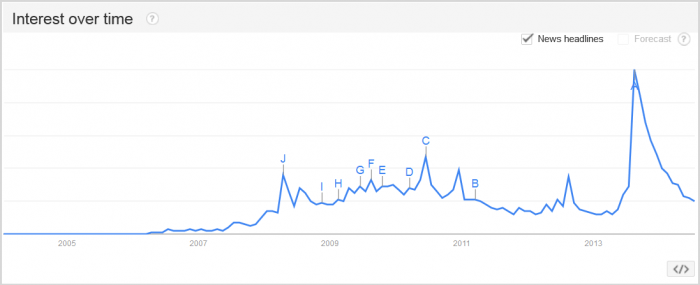 In regards to analytics and reporting, B2B marketers tend to focus on early-funnel leads and their conversion. That’s practical; generating enough qualified leads remains the #1 concern for many marketers and their organizations. However, there is much more useful information to be gained through careful reporting and analysis of key metrics at all stages of the customer lifecycle. For example, it is marketing’s role to build awareness among prospects for the company and its products, so that the top of the funnel collects enough of those convertible leads. Similarly, marketing has a role to play in customer marketing that helps in retention and upsell.
In regards to analytics and reporting, B2B marketers tend to focus on early-funnel leads and their conversion. That’s practical; generating enough qualified leads remains the #1 concern for many marketers and their organizations. However, there is much more useful information to be gained through careful reporting and analysis of key metrics at all stages of the customer lifecycle. For example, it is marketing’s role to build awareness among prospects for the company and its products, so that the top of the funnel collects enough of those convertible leads. Similarly, marketing has a role to play in customer marketing that helps in retention and upsell.
A traditional sales funnel sketches the progressive relationship between buyer and seller from the sales rep’s point of view. The “buyer’s journey” is a recreation of the steps a buyer goes through as they move from sticking with the status quo to committing to change, to researching and then deciding on potential solutions, negotiation, purchase, and post-purchase – the entire lifecycle. Sales doesn’t get involved in this journey until fairly late in the process, but marketing can, and should be there for every step of the way.
With this broader B2B customer lifecycle marketing view under consideration, we’re going to review the five sequential stages in the B2B marketing lifecycle, and discuss the metrics for each that may give us the key insights we want. In Part 1, we cover the first two stages: Attract and Capture.
The five stages of lifecycle marketing
- Attract: Getting your brand and product/service known in the marketplace, and attracting people who may be interested
- Capture: Capitalizing on the prospect’s initial attraction to you and gaining enough of the prospect’s information to start a new relationship
- Nurture: Progressive communications to answer questions and educate the prospect while building trust and reinforcing need, so that the lead continues to consider buying from the product category in general – and your product in particular
- Convert: The lead becomes a sales opportunity; you convince the lead to buy your product over both the status quo and your competition
- Expand: This stage includes retaining your customer base, generating up sells, and inspiring advocacy
At each stage there are factors you can measure that will let you evaluate how efficient your efforts are, so that you can improve them. Now, let us dive in to each lifecycle stage and explore the finer questions and key metrics that are relevant in each.
I. Attract
 The marketing lifecycle starts with attracting relevant people to your company brand and products. The typical B2B company uses some combination of content marketing, advertising, social media, tradeshows, media relations, and optimizes web efforts with search engine optimization.
The marketing lifecycle starts with attracting relevant people to your company brand and products. The typical B2B company uses some combination of content marketing, advertising, social media, tradeshows, media relations, and optimizes web efforts with search engine optimization.
Key questions you want to answer in this stage include:
- How many people visit your site?
- How attractive is your content?
- How popular is your brand?
To answer those questions, you need to select the metrics that are most relevant for your business and track them consistently, say monthly, to see a pattern. Consider:
- People visiting your web site: Track the number of individuals visiting your web site during the month. You can refer to external sources such as Google Analytics. (If you are an Act-On customer, this metric is provided in the Act-On platform.)
- Bounce rate: The percentage of visitors who enter your site and exit it on the same page – “bounce” – without visiting any other pages. By itself, bounce rate means little. If the time spent on your site is short, it could mean that your content did not engage them or was not what they were actually looking for. On the other hand, it also could mean that they were looking for just one quick thing and they found it (e.g., your address). If the time on the page is long, then the reader was definitely engaged, and found what they were looking for on this one page. Note that if your company name contains a very commonly looked for word (“deal”, “Gaga”, “Brazil”) you may get more bounces.
- Social media followers: For this metric, select a group of social media sites you are actively participating in and sum up the number of followers. Stick to the same sites as you track over time.
- Social shares: The number of shares in the given tracking period for each social media site you track.
- Number of pieces of new content on your site: This could include blog posts, web pages, white papers, webinar descriptions and registration forms, data sheets, and so on.
- Number of press releases that your PR department creates and distributes.
- Number of events that your company had an active presence in during the time period; these could be virtual or real-world.
- Google ranking: This is the most visible result of all your online activities. Pick a key word or phrase that is most relevant for your business (for Act-On, it is “Marketing Automation;” for NBA.com it would be “basketball”). Type that phrase into Google periodically and see where your site ranks. If your SEO/content efforts are consistent and more competitive than your competition’s, your company’s position will probably rise over time.
- Search volume for brand: Use Google Trends to check the trend in searches for your brand performed by people directly in the search engine. Studies indicate this is a convenient proxy for online brand awareness. Note that the values shown in Google Trends are dynamic – therefore, the individual values for a given month will keep changing, requiring historical updates. The real insight is from the trend line graph.
 The Google trend line for the keyword phrase “Miley Cyrus.”
The Google trend line for the keyword phrase “Miley Cyrus.”
The bottom line for “Attract” lifecycle activities is to measure activity so you know what works to increase your visibility and share of audience, so you can make the best decisions about increasing the distribution and appeal of your content and brand.
II. Capture
 Okay, you’ve attracted people to your website. Now what? Unless you find a way to get their contact information, you cannot start a dialog with them. That is where the “Capture” lifecycle stage comes in. The key questions you want to answer at this stage are:
Okay, you’ve attracted people to your website. Now what? Unless you find a way to get their contact information, you cannot start a dialog with them. That is where the “Capture” lifecycle stage comes in. The key questions you want to answer at this stage are:
- How many content consumers became known prospects?
- Which calls to action are the most effective? With which audiences?
- Which channels are the most effective in conveying messages?
Key metrics that help to answer these questions include:
- Conversion rate on Calls to Action (CTA): This number shows you the effectiveness of your CTA buttons in converting unknown visitors to known visitors through form fills.
- Cost per Click (CPC) and Cost per form fill: If you are using online advertising tactics like pay-per-click (PPC), these metrics are relevant.
- Number of net new prospects: The number of new prospects (from all sources) for the time period being considered.
- Leads by source: The lead source has a direct implication on the conversion potential of a lead. (Incidentally, tracking lead sources is another key benefit of using a marketing automation platform.)
You can determine the conversion rate of CTA by dividing the number of form fills (“submits”) by the number of unique views. In the Act-On platform, the conversion metric is available under Reports > Forms & Media reports.
The bottom line at this stage is to know what’s working and what isn’t, so you can plan ways to increase known prospects in the sales funnel. These will become your leads.
Stay tuned for Customer Lifecycle Marketing Reporting, Part 2, in which we’ll discuss the concerns and metrics for nurturing, late-stage conversion, and expansion.
And in the meantime…if you’re interested in how digital marketing affects the sales funnel – and have 15 minutes to spare – check out the Digital Marketing Funnel Essentials Toolkit, which will guide you to understanding the basics of digital marketing in just 15 minutes.

